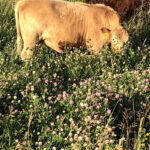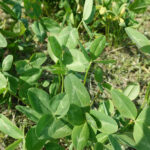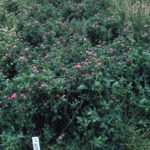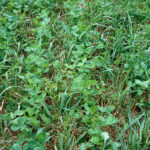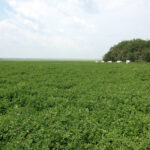Double Cut Red Clover
Trifolium pratense
General Description
Red clover is an introduced, commonly grown, shorter-lived perennial legume. Red clover needs adequate moisture in the growing season and moderate summer temperatures. It can thrive in cooler temperatures and more acidic soils than alfalfa. Single cut types, also called mammoth or late-flowering red clover, are generally hardier and most commonly grown. Double cut varieties produce multiple cuts as the name implies but lack persistence in adapted soil zones.
Each red clover crown produces many branched, hairy stems, which grow to 75 cm (30 in) in length. Leaves are made up of three hairy leaflets attached at one point and often have white “V-shaped” watermarks. Red clover produces globe-shaped, purple, cross-pollinated flowers. Once it flowers it stops growing (determinant growth) like alfalfa.
Type
Tame legume.
Origin
Europe and Turkey. Varieties such as Altaswede developed in Canada.
Longevity
Less than 5 years in the Black soil zone; however, at least 10 years is now common in rotationally grazed pastures in the Grey soil zone. Red clover crowns and roots that are close to the surface, easily damaged, and break down naturally which limits longevity.
Use
Pasture, hay, stockpiled, reclamation. Red clover can cause bloat, however, the risk of bloat is lower than for alfalfa. It is used for soil improvement in site rehabilitation in a variety of contexts.
Optimal Time of Use
Summer, fall. Delay grazing until a full canopy of leaves has developed. Delaying grazing until full bloom can prevented bloat and increased the stand persistence. Hay single cut red clover varieties at 25%+ bloom with regrowth used in fall.
Recovery After Use
Recovery after use may be varied depending on the site, moisture availability and management. Some sources indicate red clover recovers well after mid-season cutting and can be left for fall grazing. Still others advise against its use for grazing because of its inability to resist traffic from grazing animals. It is recommended to leave at least 10 cm (4 in) to allow for regrowth as recovery may depend on where the growing tip is in relation to cutting or defoliation from grazing.
Palatability/Nutritional Value
Red clover is highly palatable and may be grazed preferentially. When red clover is cut or utilized at 25% bloom, crude protein can be 19% and dry matter 65% to 70%. Weight gains on red clover are similar to gains on alfalfa.
Annual Precipitation min/max (mm)
400mm / 1600mm
Drought Tolerance
Low tolerance. Red clover is more drought tolerant than alsike clover but less than alfalfa.
Flooding Tolerance
Withstands 1 to 2 weeks of excess moisture, early in growing season; but intolerant of flooding during its actively growing period. Requires adequate moisture all season long.
Winter Hardiness
Good hardiness in single cut varieties. Fair tolerance in double cut varieties.
Soil Texture Preference
Most suited to heavier wet, fertile soils. Will grow on sandy textured soils as long as moisture is sufficient.
Erosion Control
Little ability to control erosion. Red clover has value for soil improvement in erosion control seeding and may be included in a mix.
Salinity Tolerance
Not tolerant.
Acidity Tolerance
High tolerance. Red clover can tolerate pH levels as low as 5.0 but yield is reduced significantly. Prefers pH of 6.0 to 7.0.
Alkalinity Tolerance
Moderate tolerance.
Seeds per kg
600,000 seeds/kg (272,000 seeds/lb)
Suggested Mixtures
Often grown in a mix with meadow bromegrass, timothy, smooth bromegrass, tall fescue or hybird bromegrass. Including grass in hay mixes assists with dry-down of windrows. In the Peace River Region red clover is often grown in the place of alfalfa in mixes because of its better acidity tolerance.
Ease of Establishment
Red clover is very easy to establish with moist conditions and moderate temperatures. Seedlings tend to be vigorous and shade tolerant. Use red clover the year after establishment. Red clover is successfully sod seeded.
Competitiveness
Red clover is competitive and can grow dominantly in a pasture situation for the first few years but can then decrease depending on grazing strategy. Persistence is dependent on how well the plant’s crown is maintained. Red clover is not invasive.
Management Considerations
Red clover is high in moisture and hay stands benefit from having a grass species in the mix to assist with drying-down. Short duration rotational gazing is beneficial for red clover longevity as grazing of newly emerging regrowth could be avoided. New growth is required to sustain the plant. Seed should be inoculated with Rhizobium trifolii for better nodulation and nitrogen fixing.
British Columbia Rangeland Seeding Manual, Saskatchewan Dryland Forage Species Adaptation Tool, USDA Plants Database, Manitoba Forage Adaptation and Comparison Guide, Alberta Forage Manual
Red clover is adapted to the Sub-Boreal Spruce, Sub-Boreal Pine-Spruce and Interior Cedar-Hemlock zones. It is less drought tolerant than white clover, and needs moderate temperatures. In the southern part of the Central Interior it is suited to wetter parts of the Interior Douglas-fir zone, and to irrigated and subirrigated areas in the Bunchgrass zone and dry parts of the Interior Douglas-fir zone.
Red clover is less drought tolerant than white clover, and needs moderate temperatures. This limits its suitability to the Interior Cedar-Hemlock, wetter parts of the Interior Douglas-fir zone, and to higher elevation irrigated and subirrigated areas in the Bunchgrass, Ponderosa Pine and dry Interior Douglas-fir zones.

